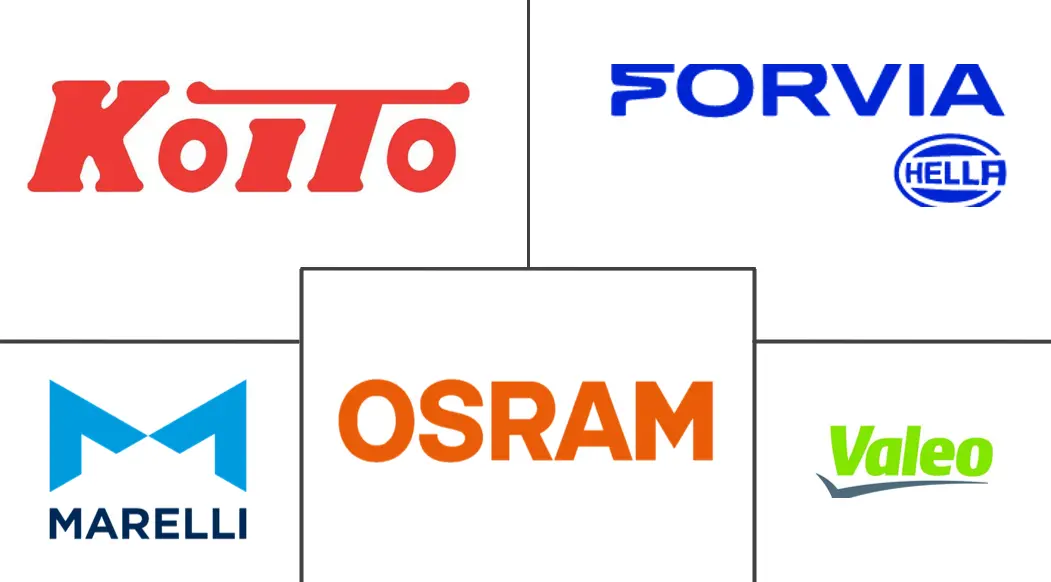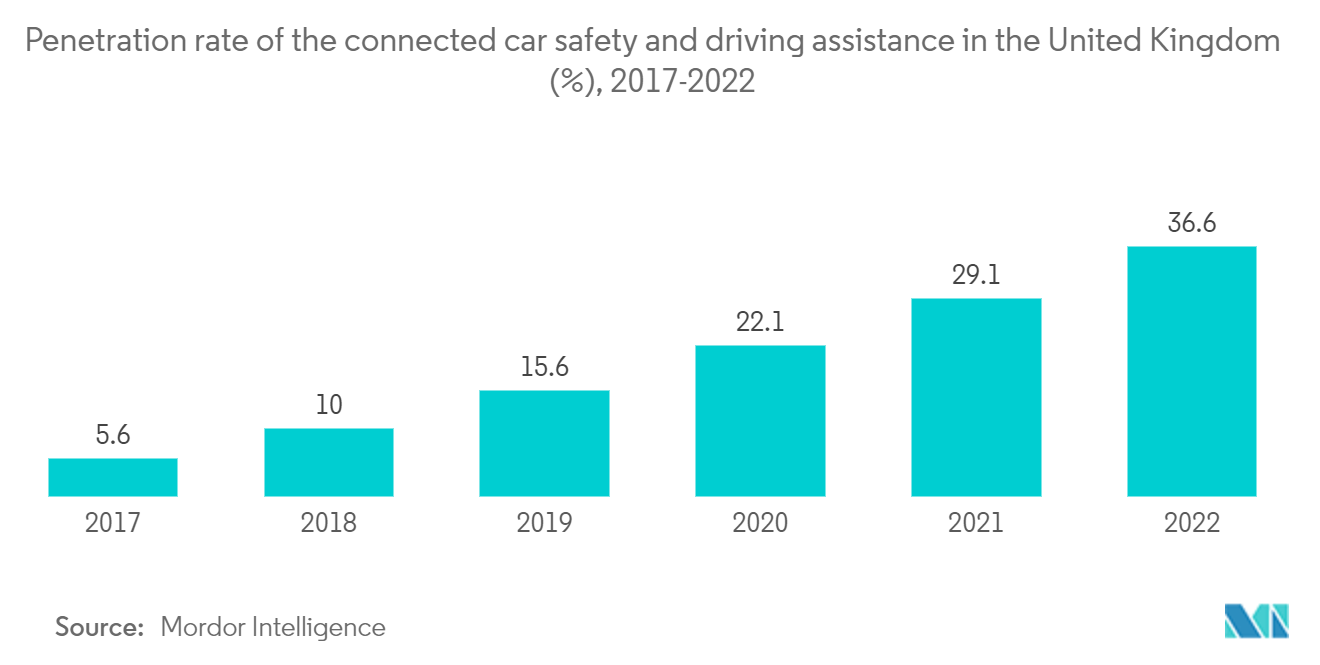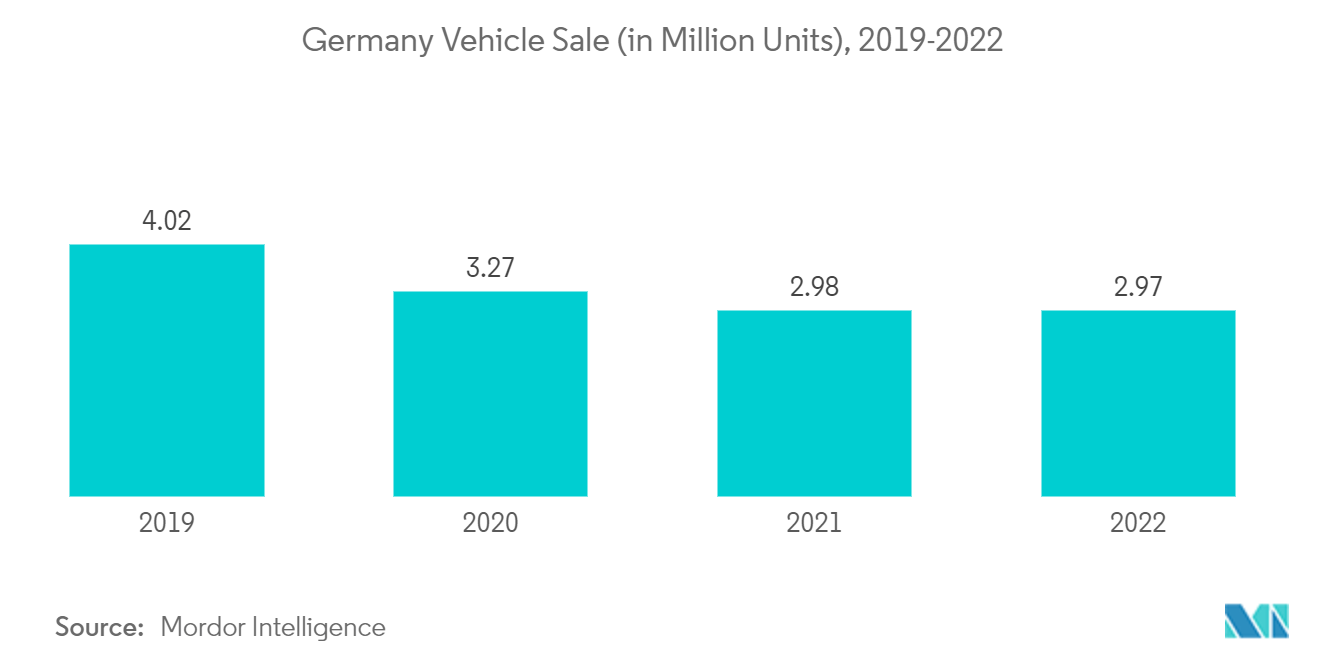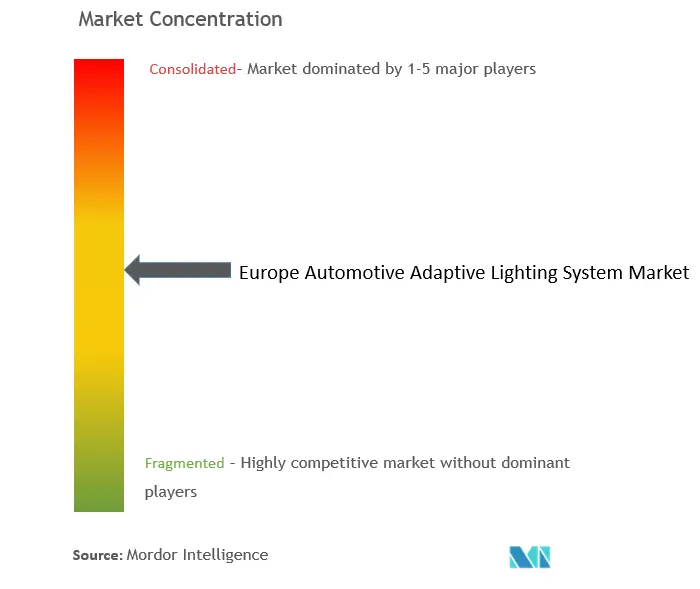Europe Automotive Adaptive Lighting System Market Analysis
The Europe Automotive Adaptive Lighting System Market size is estimated at USD 7.70 billion in 2025, and is expected to reach USD 14.82 billion by 2030, at a CAGR of greater than 14% during the forecast period (2025-2030).
- The COVID-19 pandemic had a negative impact on the market studied, primarily attributed to halted manufacturing activities. With that, the economic slowdown, coupled with the tariffs imposed on importing lights and other products, is expected to hamper the growth of this market. In addition to that, country-specific regulations for external auxiliary lights might affect the growth of the market studied.
- Over the medium term, with the situation easing, many vehicle manufacturers are showing great interest in integrating LED lights in vehicles, as these lights consume less power and have a longer life compared to halogen and HID lights. Furthermore, LED lights offer durability and strength, high-quality.
- The automotive manufacturers are investing in developing new lighting technologies and solutions that are focusing on the major lighting application, headlights. OEMs are launching vehicles with adaptive headlights to provide a safe driving experience at night.
- Trends such as autonomous vehicles and electric vehicles are evolving vehicle lighting systems. Industry participants are working intensively on various new technologies for vehicle lights with a variety of new functionalities and which can be adapted to the continuously changing requirements of future vehicles.
- Nighttime safety continues to be a major concern for transportation agencies across the region. adaptive lighting has been widely used as a countermeasure for nighttime crashes and due to lower LED and Halogen costs the demand for such adaptive lighting system expected to gain significance over the forecast period.
- Vehicle manufacturers are designing, prototyping, and testing the possibilities for external lighting. For example, Volkswagen is working on a technology that projects a pair of red warning lines on the road, when a car is turning around, thereby, letting pedestrians know where the danger zone is and presumably eliminating the problem of backing out of a high-fenced driveway, into the path of a cyclist on the footpath.
Europe Automotive Adaptive Lighting System Market Trends
Growing Adoption of Advanced Safety Features in Vehicles Will Supplement the OEM Growth
- Smart headlights are safer for nighttime driving because they illuminate more of the road without blinding other drivers, as driving with high beams on would. The study found that ADB headlights are as much as 86 percent better at providing consistent illumination in the presence of oncoming traffic.
- To overcome such challenges, several manufacturers are inclining towards the usage of smart headlights in their vehicles. Smart headlights are also known as adaptive driving beam (ADB) headlights, and such technology employs full illumination that is modified via cameras and sensors that adapt the shape, brightness, and direction of the light depending on the driving conditions.
- However, as the fitment of automatic switching functions has become more widespread, and the technology controlling this functionality has rapidly evolved, it has become apparent that some of the requirements currently specified in UN ECE Regulation No. 48 lack clarity, leading to differing interpretations of the requirements, and are not fully consistent in their application to different lamp switching functions.
- To address the rising safety concerns, various technological advancements from different companies have been witnessed in the recent past. For instance, in May 2023, Buick, a General Motors subsidiary, unveiled the next-generation LaCrosse - a full-sized sedan. The vehicle is also equipped with Matrix adaptive headlamps with 222 LED lighting sources and nine intelligent lighting modes.
- To lower the number of accidents in the nation, the Ministry of Road Transport and Highways announced that it is working on making ADAS (advanced driver assistance systems) essential for automobiles. For instance,
- As of mid-2022, all new cars put on the EU market may have to be equipped with advanced safety systems. Following an agreement with the European Parliament in March 2021, the EU Council adopted a regulation on the general safety of motor vehicles and the protection of vehicle occupants and vulnerable road users in a bid to significantly reduce the number of road casualties. Additionally, Euro NCAP, a government-backed group that rates cars for safety, may require cars to have a driver-monitoring system to earn a five-star safety rating starting in 2023 or 2024.
- Under the new rules, all motor vehicles (including trucks, buses, vans, and sport utility vehicles) may have to be equipped with the following safety features: intelligent speed assistance, alcohol interlock installation facilitation, driver drowsiness, and attention warning systems, advanced driver distraction warning systems, emergency stop signals, reversing detection systems, event data recorders, accurate tire pressure monitoring, etc.
- With the above-mentioned development across the region, the market is witnessing major growth during the forecast period.
Germany Witnessing Major Growth
- Germany witnessed an increase in the number of vehicles, including both passenger cars and commercial vehicles, in 2021 and 2022 compared to 2020. In 2021, around 3.3 million automobiles were sold in the country, which rose to an approximate total of 3.67 million units in 2022, indicating an approximate 11.21 percent increase from the previous year. Vehicle sales are predicted to climb in the forecasted period, contributing to the rising value of the automotive adaptive lighting market as life returns to routine and automotive technology advances.
- The German automobile sector is considered the world leader, with industry titans such as Volkswagen, Daimler-Benz, Porsche, BMW, and others. With a stake of more than 35%, the automobile sector in the country accounts for a large portion of the country's R&D investment. As a result of the existence of these premium automobile manufacturers, innovative lighting technology is increasing. For instance,
- Mercedes-Benz's lighting technology improved visibility by 60%. This lighting system has active lighting and cornering capabilities. In addition, the corporation has invested EUR 2.1 billion in the development of a manufacturing factory in Sindelfingen. This is projected to increase S-Class output by 25 percent in the future.
- To remain ahead of their competition, major firms in the country are developing a variety of innovative solutions. For instance, in March 2022, OSRAM announced the agreement to sell the independent and dedicated AMLS (Automotive Lighting Systems GmbH) business to Plastic Omnium for a purchase price of EUR 65 million. The transaction represents a further step in the implementation of ams OSRAM's previously communicated strategy to focus on dedicated strategic core technology and divesting businesses that are not seen as core to the corporate strategy. AMLS offers the technological brick that will provide Plastic Omnium with cutting-edge expertise in lighting technologies, electronics, and software to develop innovative lighting solutions for the automotive industry.
- In December 2021, OSRAM introduced the brightest LED for automobile front headlights on the market. Based on the aforementioned developments, the Germany Segment is to have decent growth during the forecast period.
Europe Automotive Adaptive Lighting System Industry Overview
The European automotive adaptive lighting systems market is dominated by a few players, such as HELLA KGaAHueck& Co., Stanley Electric., Philips, Valeo Group, and Others. The market is highly driven by factors like advanced technology, more use of sensors, growing investment in R&D projects, and a growing market of electric and autonomous vehicles. To provide the safest experience to the car owner, major automotive adaptive lighting system manufacturers are developing new technology for the future and acquiring small players to expand their market reach. For instance,
In March 2022, ZKW was a partner of the Swedish electric vehicle manufacturer Polestar. The 'Polestar 0' project aims to develop and launch a completely climate-neutral automobile by 2030. For this ambitious project, the Wieselburg-based lighting systems specialist will develop electronic and electrical components for Polestar. ZKW is also converting to CO2-neutral production worldwide by 2025.
In February 2022, Motherson company and Valeo signed a Memorandum of Understanding (MoU), which aims to create the vehicle interior of the future through the integration of lighting systems with advanced surface finishes.
In February 2022, Marelli announced that it would supply the new Alfa Romeo Tonale with Full-LED Adaptive Matrix Headlights. This system incorporates modes, such as "Adaptive Low Beam" and "Adaptive Driving Beam." The "Adaptive Low Beam" mode includes City, Country, Highway, and Bad Weather modes, as well as static bending lights. The "Adaptive Driving Beam" contains "Glare-Free High Beam Segmented Technology," which automatically detects traffic in front and on the opposite side of the vehicle to avoid glaring other vehicles.
Europe Automotive Adaptive Lighting System Market Leaders
-
Valeo Group
-
Magneti Marelli SpA
-
HELLA GmbH & Co. KGaA
-
Koito Manufacturing Co. Ltd
-
OSRAM GmbH
- *Disclaimer: Major Players sorted in no particular order
Europe Automotive Adaptive Lighting System Market News
- July 2023: Marelli, in cooperation with AMS OSRAM, launched a ground-breaking innovation in automotive front lighting known as h-Digi microLED module. This digital lighting solution, based on a new type of intelligent multipixel LED, enables fully adaptive, dynamic headlight operation and image projection while being an affordable technology available for a wider range of vehicles.
- January 2023: Hella GmbH & Co. KGaA (HELLA) announced the launch of the NALYSES research project to develop more sustainable headlamps in collaboration with the BMW Group, Covestro, geba, Miele, the Heinz Nixdorf Institute of the University of Paderborn, the Fraunhofer Institute for Mechatronics Design Technology (IEM), and the Hamm-Lippstadt University of Applied Sciences.
Europe Automotive Adaptive Lighting System Industry Segmentation
Automotive adaptive lighting refers to a lighting system that automatically adjusts the intensity, direction, and distribution of the headlights based on various factors like the vehicle's speed, steering angle, weather conditions, and surrounding traffic conditions. The primary goal of such a system is to enhance visibility for the driver while ensuring the safety of other road users.
Europe's automotive adaptive lighting system market is segmented into vehicle type, type, component, sales channel, and country. Based on the vehicle type, the market is segmented into passenger cars and commercial vehicles. Based on the type, the market is segmented into front and rear. Based on the component, the market is segmented into controller, sensor/camera, lamp assembly, and others. Based on the sales channel, the market is segmented into original equipment manufacturers (OEM) and aftermarket. Based on the country, the market is segmented into Germany, United Kingdom, France, and the rest of Europe.
For each segment, the market sizing and forecast have been done based on the value (USD).
| By Vehicle Type | Mid-Segment Passenger Vehicles |
| Sports Cars | |
| Premium Vehicles | |
| By Type | Front |
| Rear | |
| By Component | Controller |
| Sensor/Camera | |
| Lamp Assembly | |
| Others | |
| By Sales Channel | Original Equipment Manufacturer (OEM) |
| Aftermarket | |
| By Country | Germany |
| United Kingdom | |
| France | |
| Rest of Europe |
Europe Automotive Adaptive Lighting System Market Research FAQs
How big is the Europe Automotive Adaptive Lighting System Market?
The Europe Automotive Adaptive Lighting System Market size is expected to reach USD 7.70 billion in 2025 and grow at a CAGR of greater than 14% to reach USD 14.82 billion by 2030.
What is the current Europe Automotive Adaptive Lighting System Market size?
In 2025, the Europe Automotive Adaptive Lighting System Market size is expected to reach USD 7.70 billion.
Who are the key players in Europe Automotive Adaptive Lighting System Market?
Valeo Group, Magneti Marelli SpA, HELLA GmbH & Co. KGaA, Koito Manufacturing Co. Ltd and OSRAM GmbH are the major companies operating in the Europe Automotive Adaptive Lighting System Market.
What years does this Europe Automotive Adaptive Lighting System Market cover, and what was the market size in 2024?
In 2024, the Europe Automotive Adaptive Lighting System Market size was estimated at USD 6.62 billion. The report covers the Europe Automotive Adaptive Lighting System Market historical market size for years: 2019, 2020, 2021, 2022, 2023 and 2024. The report also forecasts the Europe Automotive Adaptive Lighting System Market size for years: 2025, 2026, 2027, 2028, 2029 and 2030.
Our Best Selling Reports
Europe Automotive Adaptive Lighting System Industry Report
Statistics for the 2025 Europe Automotive Adaptive Lighting System market share, size and revenue growth rate, created by Mordor Intelligence™ Industry Reports. Europe Automotive Adaptive Lighting System analysis includes a market forecast outlook for 2025 to 2030 and historical overview. Get a sample of this industry analysis as a free report PDF download.







